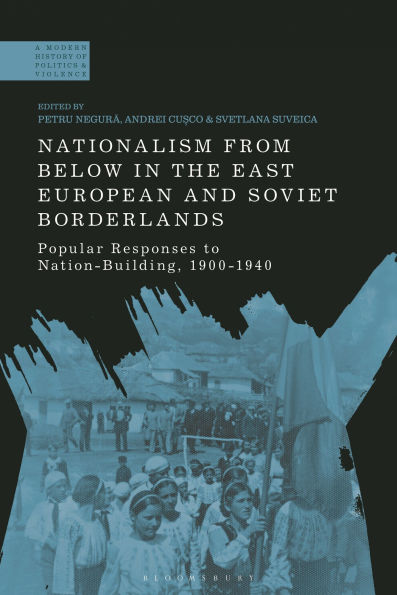Nationalism From Below in the East European and Soviet Borderlands: Popular Responses to Nation-Building, 1900-1940
Bringing together an international cast of contributors, this book engages with popular responses to nationalising and state-building projects in Eastern Europe. The volume focuses specifically on the Western border regions of the Soviet Union and the eastern provinces of Romania, Poland, and the Baltic States during the interwar period, as well as their imperial legacies, in the late-19th and early-20th centuries.
Top-down studies, which focus on political and intellectual elites, state structures and state policies, continue to dominate the historiography. Nationalism from Below in the Soviet and East European Borderlands compensates for this imbalance by approaching the East European borderlands from a 'bottom-up' perspective; it is based on the perceptions, discourses and practices of ordinary people as a response to the nation- and state-building projects. The book uses several case studies to highlight, from a comparative perspective, the local population's social and political peculiarities around national identification. It considers how these positions have changed over time and impacted the relationships between these neighbouring regions, which today make up parts of various independent states. Lastly, it reflects on how gender-based statuses and hierarchies overlap and intertwine in everyday settings of staging nationhood, alongside ethnicity, religious affiliation, class, and age.
1146221624
Top-down studies, which focus on political and intellectual elites, state structures and state policies, continue to dominate the historiography. Nationalism from Below in the Soviet and East European Borderlands compensates for this imbalance by approaching the East European borderlands from a 'bottom-up' perspective; it is based on the perceptions, discourses and practices of ordinary people as a response to the nation- and state-building projects. The book uses several case studies to highlight, from a comparative perspective, the local population's social and political peculiarities around national identification. It considers how these positions have changed over time and impacted the relationships between these neighbouring regions, which today make up parts of various independent states. Lastly, it reflects on how gender-based statuses and hierarchies overlap and intertwine in everyday settings of staging nationhood, alongside ethnicity, religious affiliation, class, and age.
Nationalism From Below in the East European and Soviet Borderlands: Popular Responses to Nation-Building, 1900-1940
Bringing together an international cast of contributors, this book engages with popular responses to nationalising and state-building projects in Eastern Europe. The volume focuses specifically on the Western border regions of the Soviet Union and the eastern provinces of Romania, Poland, and the Baltic States during the interwar period, as well as their imperial legacies, in the late-19th and early-20th centuries.
Top-down studies, which focus on political and intellectual elites, state structures and state policies, continue to dominate the historiography. Nationalism from Below in the Soviet and East European Borderlands compensates for this imbalance by approaching the East European borderlands from a 'bottom-up' perspective; it is based on the perceptions, discourses and practices of ordinary people as a response to the nation- and state-building projects. The book uses several case studies to highlight, from a comparative perspective, the local population's social and political peculiarities around national identification. It considers how these positions have changed over time and impacted the relationships between these neighbouring regions, which today make up parts of various independent states. Lastly, it reflects on how gender-based statuses and hierarchies overlap and intertwine in everyday settings of staging nationhood, alongside ethnicity, religious affiliation, class, and age.
Top-down studies, which focus on political and intellectual elites, state structures and state policies, continue to dominate the historiography. Nationalism from Below in the Soviet and East European Borderlands compensates for this imbalance by approaching the East European borderlands from a 'bottom-up' perspective; it is based on the perceptions, discourses and practices of ordinary people as a response to the nation- and state-building projects. The book uses several case studies to highlight, from a comparative perspective, the local population's social and political peculiarities around national identification. It considers how these positions have changed over time and impacted the relationships between these neighbouring regions, which today make up parts of various independent states. Lastly, it reflects on how gender-based statuses and hierarchies overlap and intertwine in everyday settings of staging nationhood, alongside ethnicity, religious affiliation, class, and age.
115.0
Pre Order
5
1

Nationalism From Below in the East European and Soviet Borderlands: Popular Responses to Nation-Building, 1900-1940
320
Nationalism From Below in the East European and Soviet Borderlands: Popular Responses to Nation-Building, 1900-1940
320Hardcover
$115.00
115.0
Pre Order

Product Details
| ISBN-13: | 9781350443754 |
|---|---|
| Publisher: | Bloomsbury Academic |
| Publication date: | 12/11/2025 |
| Series: | A Modern History of Politics and Violence |
| Pages: | 320 |
| Product dimensions: | 6.14(w) x 9.21(h) x 1.00(d) |
About the Author
From the B&N Reads Blog
